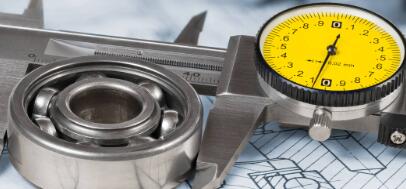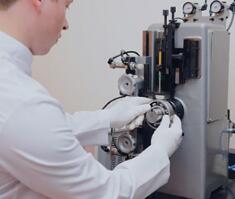How to identify a high-quality ball bearing
Learn about the key factors determining a high-quality ball bearing, including tolerance, torque, stiffness, accuracy, and lubrication.
Discover how to check for these factors during the inspection and selection process.
Ball bearings are essential in many machines and devices, but not all are created equal.
To ensure that a ball bearing performs as intended and has a long lifespan, it is crucial to identify high-quality bearings.
To identify a high-quality ball bearing, check for factors like bearing load, rotating speed, rotation accuracy, rigidity, noise & vibration, axial movement, & friction torque during the standard assessment.
Perform appearance inspection, gap measurement, & idling test during the inspection process
This article provides an overview of the key factors that determine a high-quality ball bearing, such as tolerance, torque, stiffness, accuracy, and lubrication.
Understanding these factors and how to check for them during the inspection and selection process can ensure that you are using the best quality bearings in your machines and devices.
Ball Bearings Introduction
A ball bearing is a rolling-element bearing that uses balls to maintain the separation between the bearing races.
The purpose of a ball bearing is to reduce rotational friction and support radial and axial loads.
It achieves this by using at least two races to contain the balls and transmit the loads through the balls.

Ball bearings come in a variety of designs, including:
-Deep-groove ball bearings have a shallow outer race groove and can withstand heavy radial and axial loads in both directions.
-Angular contact ball bearings can withstand heavy axial loads in one direction and have a greater thrust load capacity than deep-groove ball bearings.
-Self-aligning ball bearings have a spherical outer race and can accommodate misalignment.
-Thrust ball bearings, which are used in thrust loads and radial load capacities, are less.
One of the main advantages of ball bearings is their low friction.
Because the balls are rolling rather than sliding against the races, there is less friction than with other bearings.
This makes them more efficient and allows them to run at higher speeds.
Additionally, since ball bearings are designed to distribute the loads evenly across the balls, they can support higher loads than other types of bearings of the same size.
Ball bearings are used in various applications, including automobiles, electric motors, and household appliances.
They are also used in precision instruments and heavy industry, such as in the machinery for mines and steel mills.
In short, ball bearings are an important component in many machines and devices that require precise and efficient rotation.
Another important aspect is the maintenance of ball bearings which are generally low maintenance as they can run for a long time without much attention.
Ball bearings are an important component in many machines and devices that require precise and efficient rotation.
They are used in various applications, from automobiles and electric motors to precision instruments and heavy industry.
Their main advantages include low friction, high load capacity, and low maintenance.
They play a crucial role in the functioning of several industries and have a wide range of types and sizes according to the application.
How to identify the quality of ball bearings?
1.Standard:

-Bearing load: The capacity of a ball bearing to support loads in different directions.
This can be measured through various standardized tests.
The most common load types are Radial and Axial load. Radial load is perpendicular to the bearing's axis, while the axial load is parallel to the axis.
A good ball bearing should be able to handle both types of loads without showing any signs of deformation or failure.
It is important to select ball bearing according to the actual load requirement and application.
-Rotating speed: The maximum speed at which a ball bearing can operate without failure.
This is known as the limiting speed and is affected by factors such as the bearing's internal clearance, the viscosity of the lubricant, and the load on the bearing.
High-quality ball bearings are designed to operate at high speeds and should have a low noise and vibration level.
-Rotation accuracy: The degree to which a ball bearing meets its specifications for roundness and concentricity.
Rotation accuracy is essential for maintaining smooth rotation and preventing the bearing from producing excessive heat or causing premature failure.
High-quality ball bearings will have a low level of runout, which is the deviation of the inner and outer ring's axis.
-Rigidity: The ability of a ball bearing to resist deformation under load.
Rigidity is important because it ensures that the ball bearing maintains its shape and alignment under heavy loads, which allows for smooth rotation and low friction.
A good ball bearing should have a high degree of rigidity to ensure a longer lifespan and better performance.
-Noise and vibration: The noise and vibration level produced by a ball bearing during operation.
High-quality ball bearings will have low noise and vibration levels, indicating that the bearing runs smoothly and efficiently.
High noise and vibration levels can be caused by factors such as poor lubrication, poor alignment, or excessive internal clearance.
-Axial movement: The degree to which a ball bearing allows axial movement of the shaft it supports.
This is also known as axial play. In some cases, axial movement is desirable, as it allows for slight adjustments to the alignment of the shaft.
However, in most cases, a low level of axial movement is desirable, as it allows for a more precise alignment of the shaft and prevents excessive wear on the bearing.
-Friction torque: The amount of torque required to rotate a ball bearing.
This indicates how easily the bearing can be rotated and how much energy is lost due to friction.
High-quality ball bearings will have a low friction torque, indicating that the bearing is running efficiently and effectively.
2.Inspection:

-Appearance inspection: A visual inspection of the ball bearing's surface, looking for any signs of damage, wear, or defects.
This can include checking for any visible signs of rust, cracks, or other damage to the outer race, inner race, or balls.
Any damage can impact the bearing's performance and lifespan, so it is important to thoroughly inspect the bearing before installation.
-Gap measurement: The measure of internal clearances of the ball bearing, which is the difference between the inner diameter of the outer race and the outer diameter of the inner race.
Internal clearance is an important factor in determining the bearing's performance.
An appropriate internal clearance should be selected based on the type of load and the operating conditions of the bearing.
-Idling test inspection: A test performed when the bearing is idle to check for any noise or vibration.
This can be done by holding the bearing in your hand or with the aid of a sound level meter and rotating the outer ring of the bearing with a finger.
Key Factors Affecting Quality
1.Tolerance:
Tolerance is the degree of precision with which the different components of a ball bearing are manufactured.
It is important to maintain tight tolerances when manufacturing ball bearings because small variations in the size and shape of the components can greatly impact the bearing's performance.
For example, if the bore of the inner ring is too large or too small, it can cause the bearing to fail prematurely or produce excessive heat.
High-quality ball bearings are manufactured to very tight tolerances to ensure that they perform as intended.
2.Torque:
Torque is the force required to rotate a ball bearing. It is important to select a ball bearing with low torque, as this indicates that the bearing runs efficiently and effectively.
Factors affecting torque include the bearing's internal clearance, the lubricant's viscosity, and the load on the bearing.
High-quality ball bearings are designed to have a low torque, which allows them to run at high speeds and with less energy loss due to friction.
3.Stiffness:
Stiffness measures how much a ball bearing resists deformation under load.
It is important for ball bearings to have a high degree of stiffness, as this ensures that the bearing maintains its shape and alignment under heavy loads, which allows for smooth rotation and low friction.
Factors affecting stiffness include the type of bearing, the materials used, and the manufacturing processes.
High-quality ball bearings are designed to have a high degree of stiffness, which allows them to support heavy loads and last longer.
4.Accuracy:
Accuracy is the degree to which a ball bearing meets its specifications for roundness and concentricity.
Rotation accuracy is essential for maintaining smooth rotation and preventing the bearing from producing excessive heat or causing premature failure.
High-quality ball bearings will have a low level of runout, which is the deviation of the inner and outer ring's axis.
Several factors, including the material, heat treatment, manufacturing process, and clearances determine the level of accuracy.
5.Lubrication:
Lubrication is applying a lubricant, such as oil or grease, to the bearing to reduce friction and wear.
Lubrication is essential to the performance and lifespan of a ball bearing.
A good lubricant will minimize friction, reduce wear, prevent rust, and act as a coolant.
Lack of proper lubrication or inappropriate lubricant can lead to increased wear and tear, friction, heat generation, and even bearing failure.
High-quality ball bearings are designed to be used with specific types of lubricants, and it is important to use the recommended lubricant to ensure optimal performance.
Tolerance, torque, stiffness, accuracy, and lubrication are key factors affecting ball bearings' quality.
These factors have a direct impact on the ability of the bearing to support loads, operate at high speeds, maintain accurate rotation, and resist wear.
High-quality ball bearings are designed to meet tight tolerances, have low torque, high stiffness, high accuracy, and the correct lubricant to ensure optimal performance and longevity.
Conclusion
By understanding and applying the tips on identifying a high-quality ball bearing, you will be able to ensure that your machines and devices have the best possible performance and lifespan.
Implementing these standards and inspections will greatly benefit and improve the equipment's overall performance, efficiency, and longevity.





